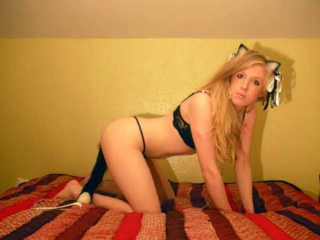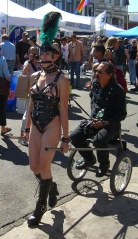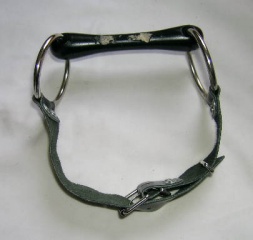 |
Peter Masters |
Peter Masters |
|
|
|||||
| About me | About this site | My books | |||||||
Animal play
Contents
What it is
Animal play is where a submissive dresses as animal, behaves or adopts characteristics of an animal, or is treated by their partner as an animal. Most commonly in BDSM play the animal will be a kitten, a puppy, or a pony, though other animals are less frequently chosen.
Why do it
Animal play allows the participants---the dominant and their submissive---to express things or behave differently than they might when not "in role". For example, a kitten is typically mischievous and difficult or impossible to control or train. A pony, on the other hand, can be dressed up and taught to perform. Animal play can therefore be a useful way to demarcate completely different ways of behaving. For example, a service-oriented submissive can completely escape the service role by entering into a kitten role. The expectations placed on them by themselves and their partner are completely different in both cases while still retaining the disparity of power characteristic of BDSM.
Objectification can be a significant part of animal play as it allows the submissive to reduced from human. Engaging an animal is inherently simpler than engaging an adult human. This means that any "vocabulary" used between the dominant and the submissive is also reduced to simple verbal commands, gestures, tapping with a riding crop, tail-wagging, whinnying and so on. Enforcing or requiring this simpler interaction can directly relate to achieving subspace which is often itself a simpler or less active state of mind than normal.
Animal play creates opportunities for other forms of play to combined with it. Humiliation can be part puppy toilet training, for example.
Even when not behaving or presenting as an actual animal a dominant may engage their submissive in animal-like terms such as, "my pet," or "kitten," and these can represent an underlying leaning towards objectification or reduction of the submissive. Likewise, a submissive may display animal characteristics without fully entering an animal role to also partially reduce themselves---mischievousness or friskiness, for example, are not uncommon in some submissives.
Notes regarding particular types of animal play
- No speaking or talking. Animals don't talk.
Kitten play

Kitten play
- Playful - kittens are often playful, but this may be more self-motivated rather than engaging with their masters. Kittens don't typically play fetch, for example
- Mischievous - the natural mischievousness of a kitten provides an opportunity for a submissive to (playfully) misbehave and get stern rebukes from their dominant
- Punishment - kittens are typically less associated with the idea of punishment or discipline than a puppy, but it can occur in regards to toilet training
- Toilet training - toilet training is less associated with kittens and cats than it is with puppies
- Other training - kittens and cats are notoriously untrainable
- Communicating - kittens communicate with mewing, hissing, arching their back, etc.
Puppy play
- Playful - puppies are often playful and can chase balls and fetch sticks
- Training - older puppies can be trained to follow verbal orders such to sit up, beg, roll over and, importantly, heel. Puppies and dogs can be lead around on a leash
- Feeding - puppies feed from one bowl and drink from another
- Toilet training - puppies often need toilet training and this provides opportunities for correction and discipline, and for humiliation when performed in front of others
- Communicating - puppies communicate with barks and growls
Pony play

Ponygirl pulling a cart

A pony bit with short leather straps suitable for use on a human pony. Note the teeth marks
- Service - ponies are often associated with service. Ponies can pull carts carrying good or equipment, or can pull a sulky carrying their dominant or master. They can wear a saddle but only carry someone very light, such as a small dominatrix. Some male ponies can carry their partner on their shoulders while standing or walking
- Prancing and dressage - ponies can be taught to prance, walk and generally follow choreographed routines in styles reminiscent of dressage
- Decoration - ponies may be dressed up with decorated head gear, blinkers, bridles, halters, and butt-plug tails
- Training - in a more general sense ponies can be trained to follow verbal orders, be directed or disciplined with a riding crop, be trained to prance, canter, gallop, etc.
Humiliation
Humiliation can be part of animal play. While animals themselves don't get humiliated, and someone who is deep in an animal role is likewise not going to get humiliated, someone who is being compelled to act or look like an animal can be effectively humiliated. For example, the following can be made to be humiliating or mocked:
- Being decorated and paraded in front of others,
- Having a butt-plug tail
- Eating from a dog bowl or feed-bag
- Pissing or shitting in front of others while on all fours
- Being required to chase sticks
Curiously
It's a curious thing that animal role playing usually involves just:
- Kittens
- Puppies
- Ponies
This is mostly because these are animals which characteristically are involved with people through service, playfulness, or mischievousness.
There are also animals which don't appear in animal role playing. These generally don't have any close association with people. They include:
- Elephants
- Zebras
- Snakes
- Sparrows
- Fish
- Beetles and mosquitoes
- Spiders
- Pelicans
- Microbes
- Shellfish
- Whales